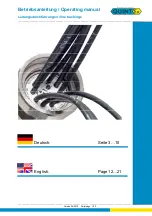
9
mechanical protection for fiber bundles as
required.
14.02
Loose Tube Bundles
Starting with the
Express/Feeder cable(s), provide a method of
identifying and separation for the Input versus
Output Express/Feeder bundles. Then, route the
Input and Output bundles into the flexible routing
clips that are aligned with the center sections’
hanger attachment.
14.03
Turn the center section over onto the
Drop/Lateral side and route the Drop/Lateral
loose tube bundles into the same routing clips
with the Express/Feeder bundles. Again, provide
a method of identifying the bundles.
Note: If all fibers in the Drop/Lateral cable
bundles are not assigned for splicing, the AFL
1x6 Router Kit (P/N: FC000070) is recommended
for use to route those fibers into the tray at this
time.
14.04
Route all bundles around the center section and
direct them back towards the cable seals.
14.05
Temporarily install a splice tray into the tray
support. While maintaining minimum bending
radii, route a bundle up and into the tray. Place a
mark on the bundle for the desired opening (this
routing will provide sufficient working slack and
bare fiber for splicing). See
Figure 10c
.
\
Ribbon Bundles
14.06
Starting with the Express/Feeder cable(s),
provide a method of identifying and separation
for the Input versus Output bundles. Route the
Input and Output bundles in and out of the
transition area.
14.07
Using either solid transition tubing or flexible
spiral wrap, route the two bundles around and
through the routing rings and back towards the
sealing clamps.
14.08
Rotate the closure over to the Drop/Lateral side
and then route the drop cable bundles into the
flexible routing rings to join up with the
Express/Feeder bundles.
14.09
Determine the amount of slack required and
mark all bundles. Dress slack back towards the
storage area.
Note: If the ribbons are to be single fused, treat
the ribbon in the same manner as a loose tube
with all slack fiber not needed, route and store in
the tray.
14.10 Express/Feeder Cable (Loose tube and
Ribbon)
Express Fiber Bundles can be safely
stored on the Express/Feeder side of the closure
until required for splicing. Ribbon bundles can be
stored in either the molded-in transition area or in
the optional Slack Storage Module. Loose tube
bundles can be stored in the routing rings. See
Figure 10d and 10e
.
14.11 Loose Tube Bundles
Separate the loose
tube(s) required for mid-access splice and store
the remainder in the routing rings.
14.12
Route the tube(s) into the routing rings and
rotate the closure to the drop side.
14.13
Route the Drop/Lateral bundles to join up with
the Express/Feeder bundles and route all up to
the splice tray.
Mark the bundles as ‘entry
bundles’.
Note: If all fibers in the Drop/Lateral cable
bundles are not assigned for splicing, the AFL
1x6 Router Kit (P/N: FC000070) is recommended
for use to route into the trays at this time.
14.14
Ribbon Bundles
Express or mid-accessed
Ribbon Bundles are stored in the transition area
of the closure. Remove the bundles required for
splicing and store all unused bundles into the
storage or module area.
14.15
Route the required bundles around to the
Drop/Lateral side using the routing rings.
Ribbon
Figure 9c - Routing/Marking Bundles for Tray Entry
Figure 10c –
Routing/Marking
Bundles for Tray Entry
Figure 9d - Express Routing
Figure 10c – Express
Routing
Figure 9e - Express Routing
(Central Core Ribbon or Loose Tube Bundles)
Figure 10e – Express
Routing
(Central Core Ribbon or Loose Tube Bundles





























